Yoga’s warrior pose (virabhadrasana in Sanskrit) stands as a symbol of strength and endurance, embodying the qualities of the fierce warrior Virabhadra from Hindu mythology. This formidable asana, in its three forms, is an expression of physical prowess and a testament to mental resilience—and it makes you feel strong AF when you can nail it.
Warrior 1 builds strength and flexibility in a forward-facing stance, emphasizing hip and chest opening. In contrast, warrior 2 takes a sideways stance, targeting leg strength, hip opening, and shoulder alignment. Warrior 3, the most advanced, involves balancing on one leg while leaning forward, enhancing balance and whole-body strength.
Experts In This Article
- Jessie Mahoney, MD, RYT-200, founder of Pause & Presence Coaching and Retreats and Mindful Yoga for Healers
- Linda Lang, E-RYT, CYT, ACEP, certified yoga therapist, director of Yoga As Lifestyle Medicine, and advisory council member for International Association of Yoga Therapists
While these poses convey strength and power, it’s important to practice them with proper alignment to avoid straining the knees, lower back, and shoulders. In this guide, we explore how to get into warrior pose 1, 2, and 3, as well as how each variation fortifies your whole body and helps sharpen your mind.
In This Article
Benefits of warrior pose
Why practice warrior pose? This asana is ideal for enhancing lower-body strength, improving balance and flexibility, and boosting concentration and stamina. It’s a comprehensive asana that works on both the physical and mental aspects of your practice.
Whole-body engagement
“Warrior pose is a whole-body workout, from the soles of your feet to the tips of your fingers,” says Jessie Mahoney, MD, founder of Pause & Presence Coaching and Retreats and Mindful Yoga for Healers. “It engages the big and small muscles, which enhances both physical strength and mental focus.”
Science backs this up: Recent research highlights1 that a thrice-weekly yoga practice, which included warrior pose, improved balance and flexibility, with additional benefits in body recomposition.
Strength building
Physically, warrior pose 1 lays the groundwork by building lower-body strength, enhancing flexibility in the hips and shoulders, and improving balance. Warrior 2 expands on these benefits by engaging the entire body, fostering stamina, and honing concentration. Warrior 3, often seen as the pinnacle of the warrior series, pushes these boundaries, intensifying the challenge to balance and focus.
A 2021 study in the International Journal of Sports Physical Therapy2 found impressive strength benefits for warrior 3 pose, specifically for the lower leg muscles, gluteus medius and maximus.
“When practiced as a series, you experience warrior 1 as the archer’s bow, warrior 2 as the arrow, and warrior 3 as the arrow in flight,” explains Linda Lang, director of Yoga As Lifestyle Medicine and advisory council member for International Association of Yoga Therapists.
Each pose requires “bold expression, supreme expansiveness, structural stability and core strength, with a psychological perseverance that conveys both prowess and perspective,” she says.
Mindfulness mastery
“The practice of warrior pose transcends physical engagement, inviting mental clarity and focus,” says Lang.”It’s about cultivating a mindset that can observe and respond without judgment.”
In warrior pose, the commitment to balance and control is more than just physical; it’s meditation in motion. A paper in Frontiers of Human Neuroscience describes how yoga cultivates self-regulatory processes, helping them becoming more automatic and efficient over time, aiding in stress management.
“It’s meditation in motion.”
By fostering a state of concentration, yoga’s warrior poses become a vehicle for self-awareness, helping you look at both your internal and external environment. This mindful approach builds mental resilience, empowering you to face life’s challenges with a warrior’s grace—both on and off the mat.
Warrior pose techniques
The warrior series—warrior 1, 2 and 3—strengthens the entire body as well as enhances alignment and builds stability. Below, you’ll find form tips for each warrior pose as well as instructions for building up to the peak asanas.
As we explore these foundational yoga poses, we will also touch on the aspect of mindfulness and connecting the pose with your breath. Holding all warrior posse for 5 to 10 breaths is generally recommended. However, the duration can be adjusted based on your comfort level and experience. The focus should be on maintaining good form and steady breathing while holding the yoga pose.
Whether you’re a seasoned yogi or a beginner, understanding the technique and variations of warrior pose is key to reaping its full benefits and infusing your practice with strength and mindful presence.
Warrior 1
Feeling stronger and more balanced in all three warrior poses means embarking on the journey with warrior pose 1 (virabhadrasana I).
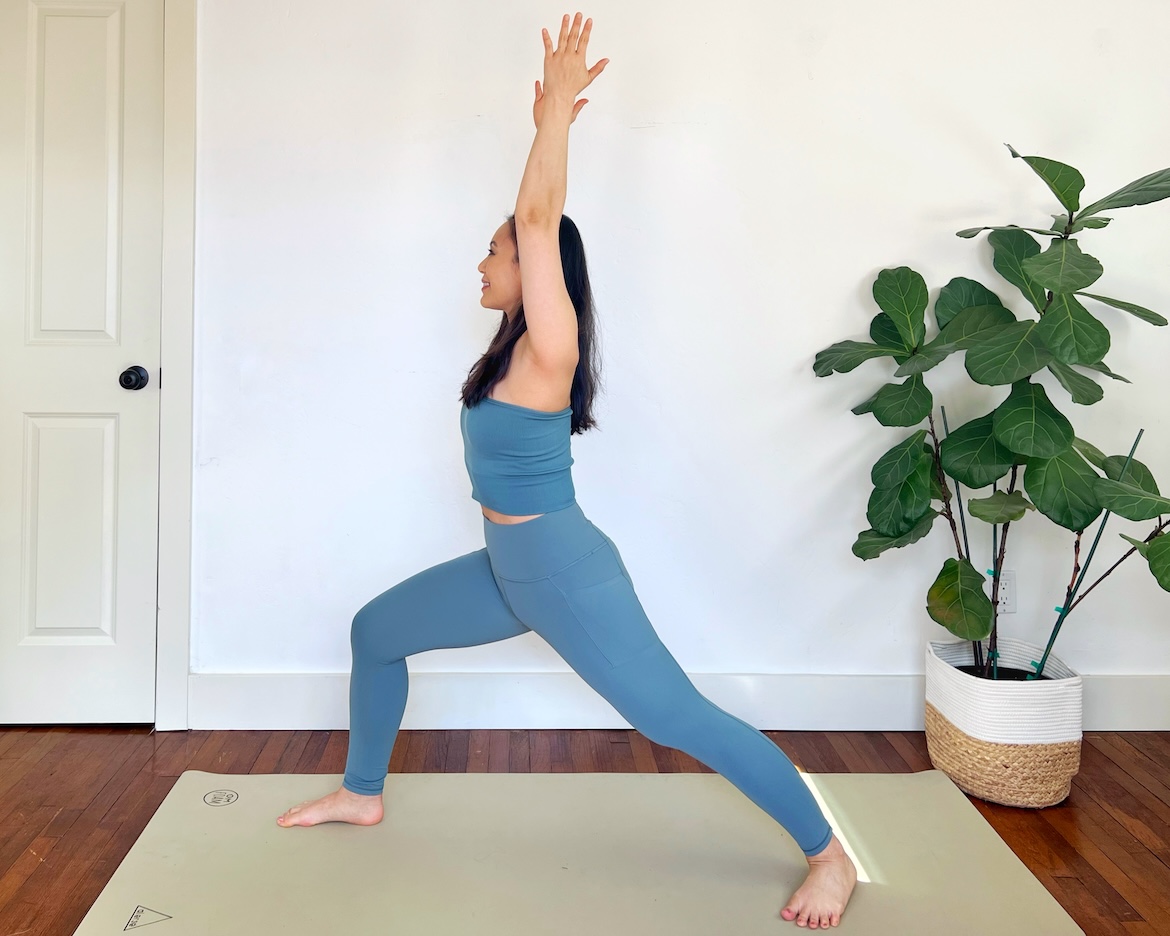
- Begin in a standing position on your yoga mat with your feet hip-width apart. Stand tall and grounded.
- Take a deep breath and on your exhale, step one foot back about three to four feet. Turn this foot out slightly to about a 45-degree angle, ensuring stability.
- Envision an imaginary line extending lengthwise down the center of your mat and position each foot on opposite sides of the line to maintain hip-width distance and balance.
- Bend your front knee, aiming to get it directly over your ankle.
- Keep your back leg strong and straight, pressing through the outer edge of your back foot for balance.
- Inhale and raise your arms overhead, keeping them parallel, with palms facing each other or touching.
- With your arms reaching up, focus on lengthening your spine. Keep your shoulders relaxed and away from your ears.
- Hold this position for 5 to 10 breaths. Stay focused on your breathing, maintaining a balance of strength and ease in the pose.
- To release, exhale and lower your arms, stepping your back foot forward to return to a standing position.
- Repeat on the other side.
Warrior 2
Warrior 2, a dynamic standing pose, demands not just physical strength but also an unwavering gaze and concentration. It’s a perfect blend of focus and resilience.
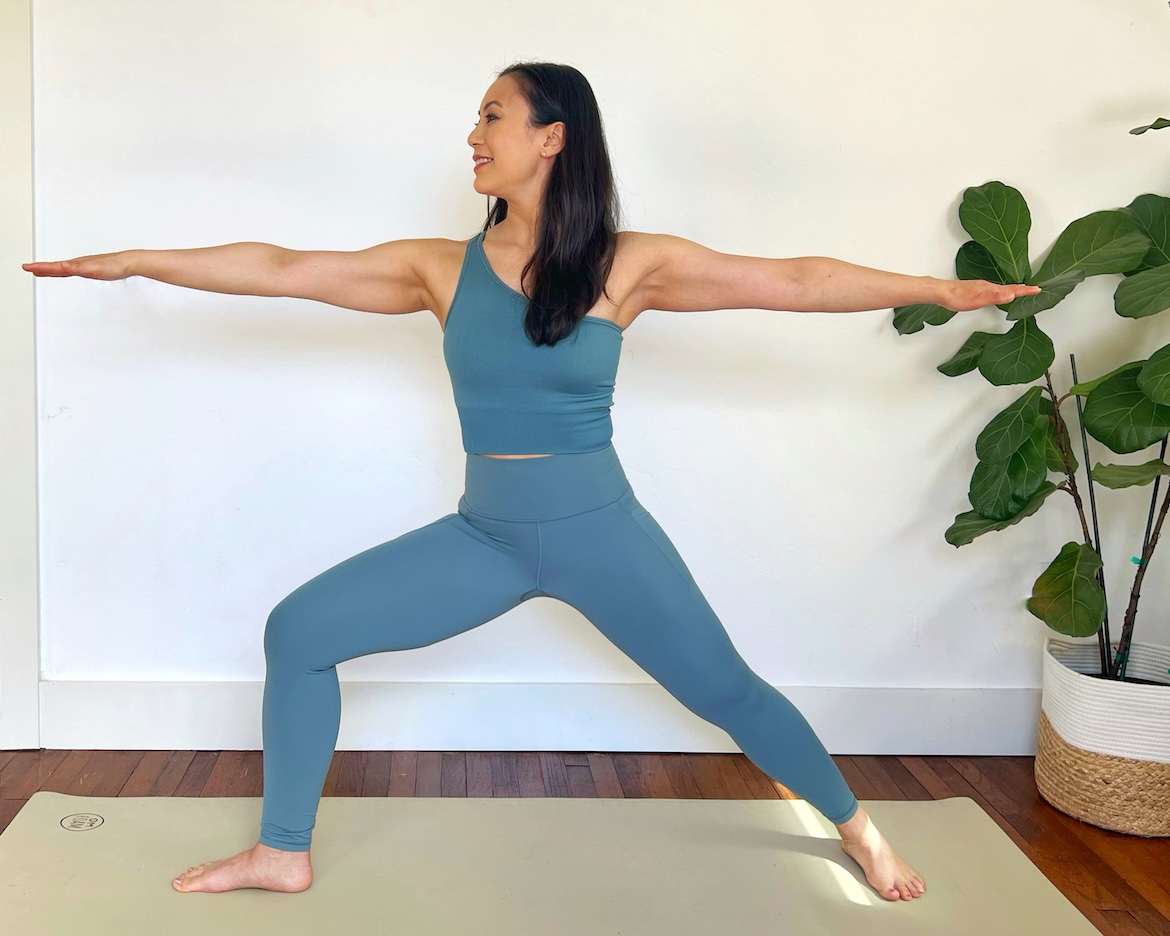
- Start in a standing position on your yoga mat, feet hip-width apart, grounding yourself and standing tall.
- With a deep breath, step one foot back about three to four feet. Turn this foot out to about a 90-degree angle, ensuring your feet are aligned heel to heel.
- Bend your front knee, aligning it directly over your ankle. Your front thigh should be parallel to the floor.
- Extend your arms out to the sides at shoulder height, keeping them parallel to the floor, palms facing down.
- Turn your head to look over your front hand, keeping your torso long and upright.
- Press firmly into the outer edge of your back foot, maintaining a strong, straight back leg.
- Hold this position for 5 to 10 breaths, focusing on the strength and stability in your legs and the openness in your chest and arms.
- To release from warrior 2, inhale and straighten your front leg, lowering your arms, then step forward to return to a standing position. Pause to notice the energy flowing through your body.
- Repeat on the other side.
Warrior 3
In warrior 3, balance meets strength. It is one of those advanced yoga poses where the thrill of ‘flying’ is so exhilarating that you’ll find yourself wanting to include it in every yoga session. It will test your limits and leave you feeling like you can conquer any challenges that come your way, on or off the mat.
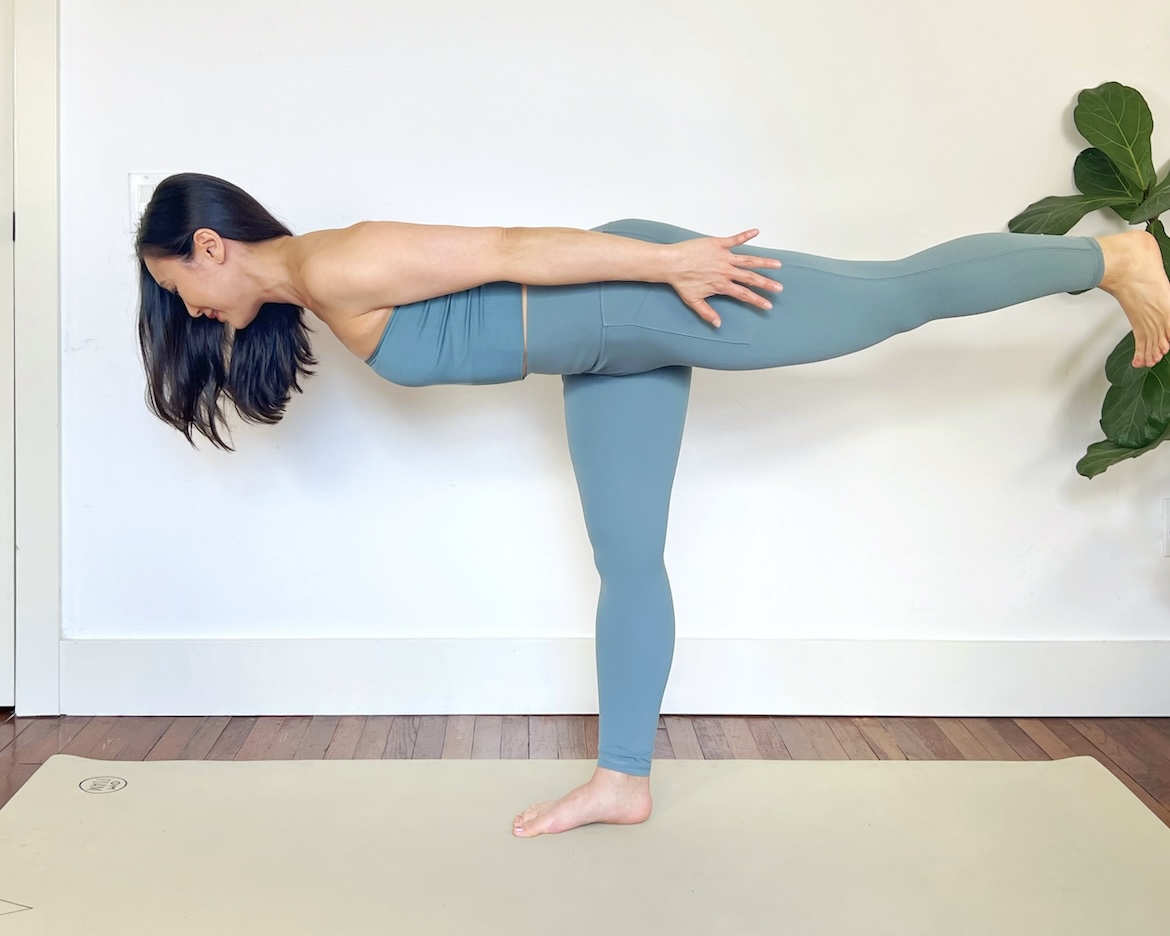
- Begin in a standing position on your yoga mat with your feet together.
- Shift your weight onto one foot, keeping that leg strong and engaged.
- As you inhale, start to hinge forward at your hips while simultaneously lifting your other leg up behind you. Aim to bring your body and raised leg parallel to the floor.
- Extend your arms forward, in line with your ears, or alongside your body for balance (pictured). Keep your gaze fixed on a point on the floor for stability.
- Engage your core to maintain balance. Keep your hips square to the ground and your raised leg straight and active with a flexed foot.
- Hold this position for 5 to 10 breaths, focusing on maintaining a strong, steady breath as you balance.
- To exit warrior 3, slowly lower your raised leg as you return to a standing position. Take a moment to feel the equilibrium and strength in your body.
- Repeat on the other side.
5 expert tips on mastering warrior pose
1. Activate your entire body (plus your mind)
Mahoney emphasizes using your whole self to create and hold the warrior poses. This means engaging your body and mind actively during the pose.
To achieve this, she advises paying attention to everything from the soles of the feet to the tips of the fingers.
2. Engage your toes
Mahoney highlights the importance of engaging your toes, like a child learning to walk. Re-engaging with your feet and toes in warrior poses helps use, strengthen, and appreciate all your resources.
3. Ground down
Lang points out that visualizing “grounding down” can help you balance and activate muscles throughout your body. This ensures that your joints are supported and strength is built from the ground up.
4. Engage your core and upper body
By engaging your core and upper body, you distribute the effort across your whole body, not just your legs. Think about actively drawing your shoulder blades down your back.
5. Listen to your body
If your front quad burns in warrior 1 or 2, feel free to straighten your leg for a bit. With time, your strength will increase, allowing you to hold the pose longer comfortably.
Modifications for all warrior poses
If you’re a beginner yogi, you’ll want to start with warrior pose 1 (virabhadrasana I) for a solid foundation. Lang encourages the use of props (see below for how to use), as they “can be seen as loving gestures to support your full expression in each pose, signifying advanced practice and self-awareness.”
Using props “signifies advanced practice and self-awareness.”—Linda Lang
If you’re struggling with balance in warrior 1, 2, or 3, use a wall for support.
Once you feel strong in warrior 1, gradually progress to warrior pose 2 (virabhadrasana II) for enhanced hip opening and upper body strength. As your confidence builds, try warrior pose 3 (virabhadrasana III) to challenge your balance and strength further.
Warrior 2 modification: Twist and Roar
Adding a twist to any pose can enhance spinal flexibility and engage the core. Integrate a twist in your warrior 2 to add some challenge and change your perspective.
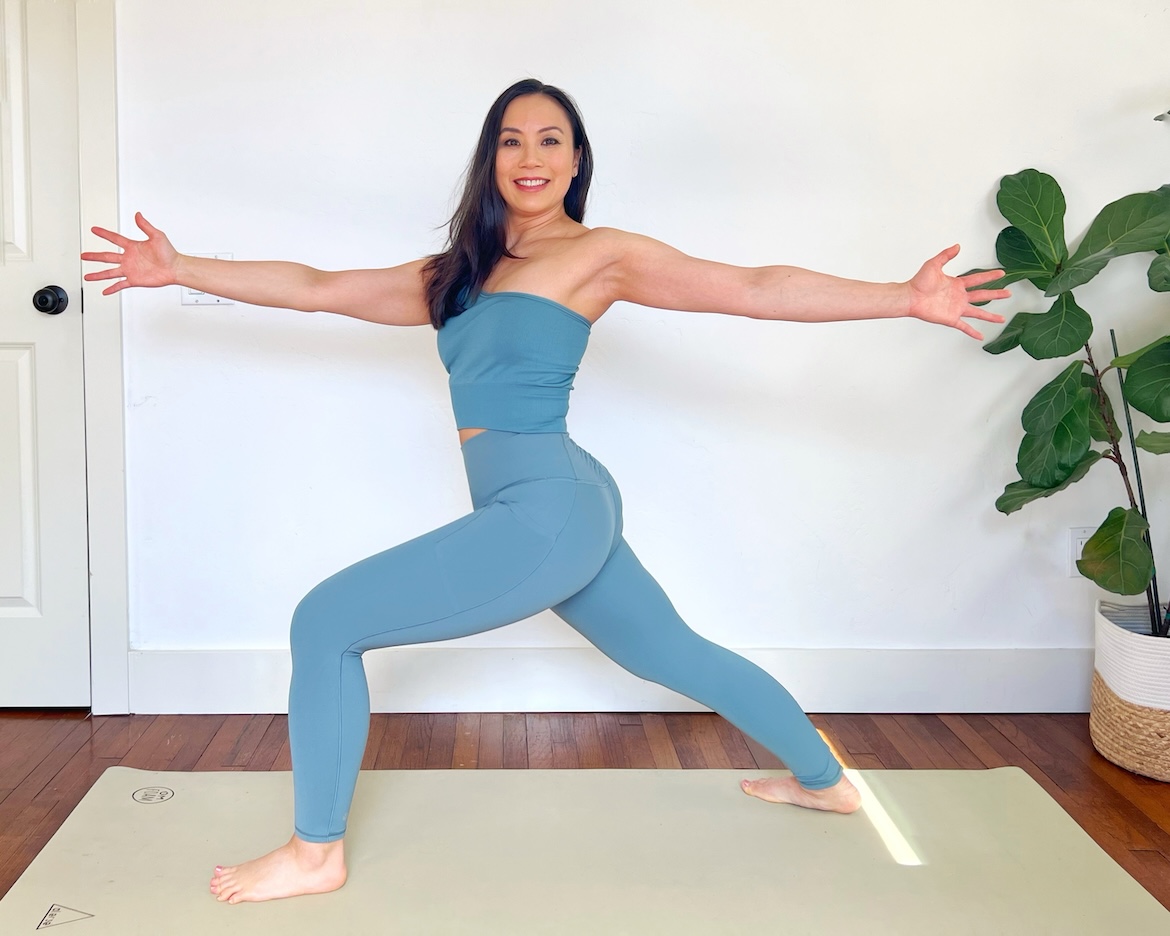
- Begin in warrior 2 with your left foot forward and your arms extended.
- Without moving your legs, twist your upper body to the left.
- Keep your right arm extended forward at shoulder height and swing your left arm back, parallel to the right.
- Turn your head to gaze over your left hand, keeping your spine elongated.
- Ensure your left knee stays aligned over your ankle.
- Hold the pose for 3 to 5 breaths, feeling the twist in your torso.
- Inhale to come back to warrior 2.
- Switch sides and repeat, this time with your right foot forward and twisting to the right.
How to modify the warrior poses with props
Block between knee and wall:
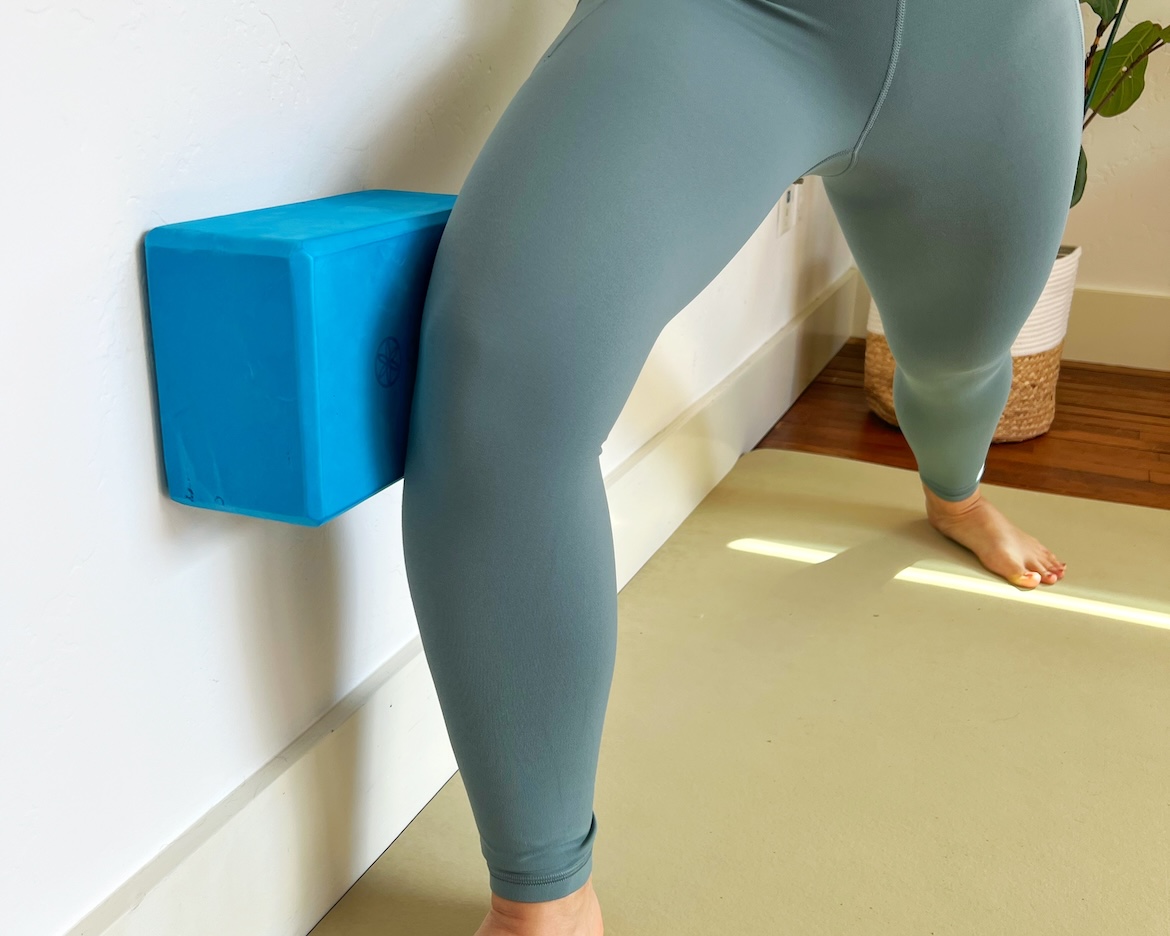
In warrior 1 or 2, place a block between your front knee and a wall. This helps engage the quadriceps and glutes more effectively.
Block between hands:
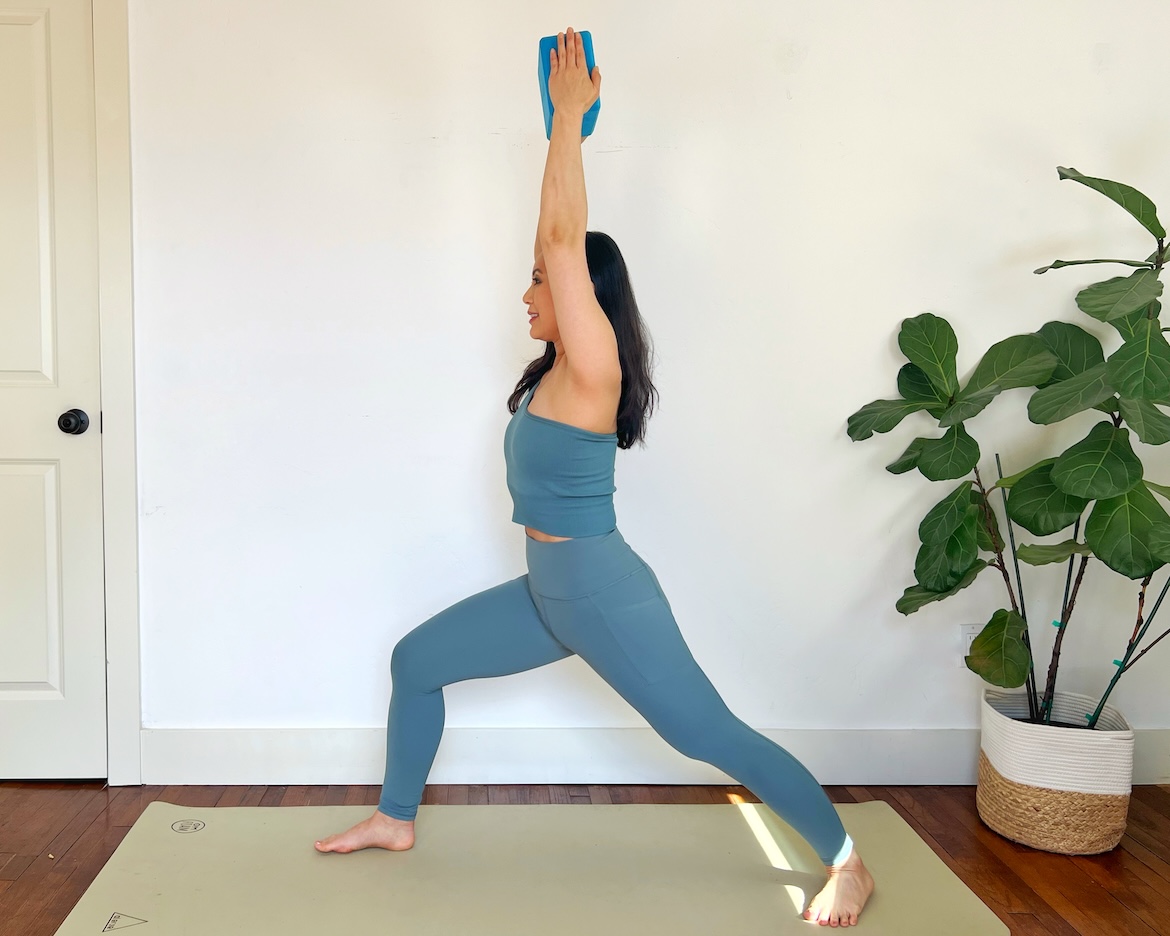
Try pressing a block between your hands in warrior 1 or 3. This helps maintain shoulder alignment and engages the arms and core, boosting upper-body strength and stability.
Folded blanket under the heel:
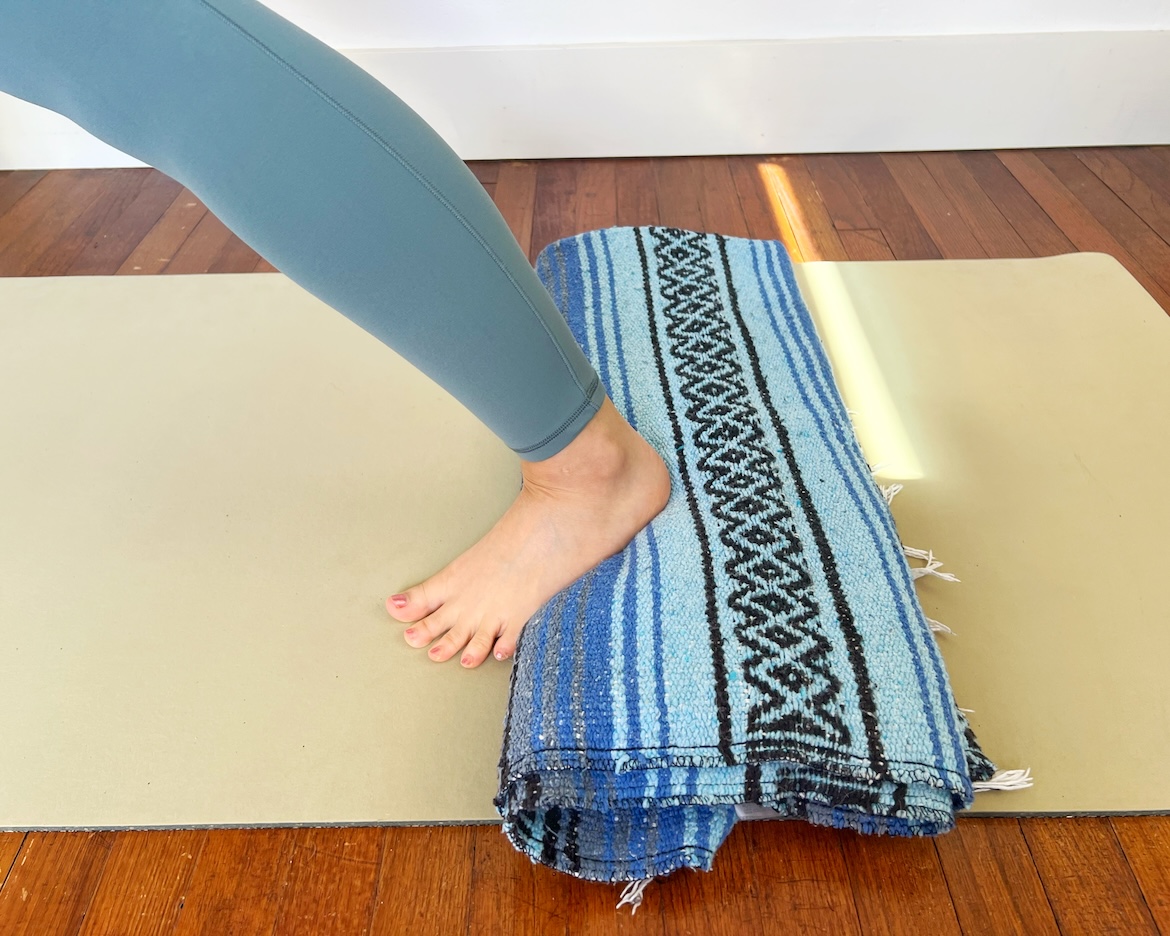
For those with tight ankles or calves, place a folded blanket under the heel of the back foot in warrior 1. This provides support, making the pose more accessible.
Third point of contact for warrior 3:
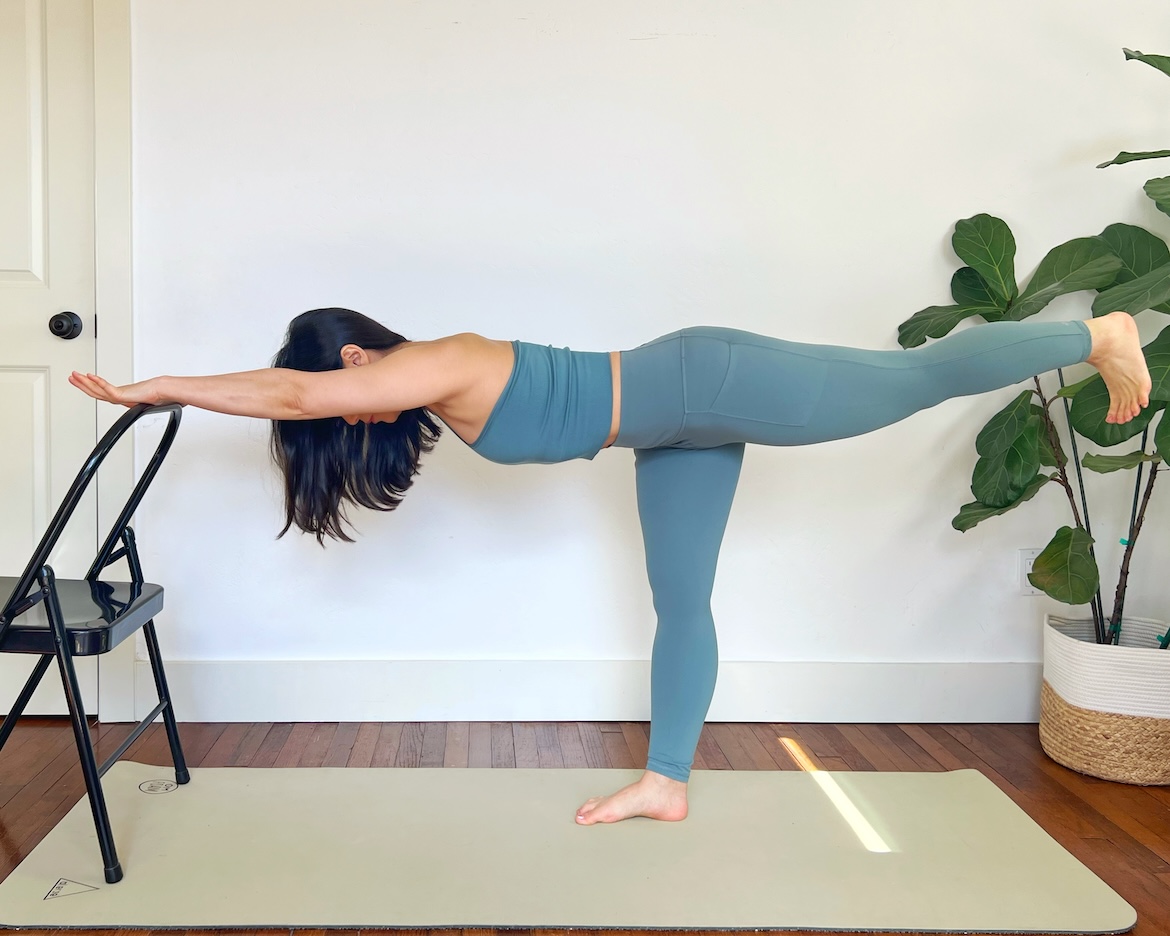
If you find holding a wall on one side still isn’t enough stability in warrior 3, use the back of a chair in front of you to rest your hands to help with balance.
Avoid these common mistakes in warrior poses
Mastering the warrior poses in yoga involves awareness of common mistakes and knowing how to correct them. Proper alignment and mindful movement are crucial for avoiding injury and maximizing the benefits of these poses. Here’s a closer look at some typical errors and tips on how to correct them:
Misalignment of the knee
In warrior 1 and 2, a frequent mistake is misaligning the front knee, either extending it beyond the ankle or letting it collapse inward. Instead, align the front knee directly over the ankle, forming a right angle. The knee should be aligned with the second toe to prevent stress on the knee joint. If you look down and can’t see your big toe, your knee is tracking too far in.
Foot positioning
Mahoney advises paying careful attention to foot position to prevent strain. “Lengthen your stance and ensure heel to heel alignment to help find a stable base,” she says.
Overstraining the lower back
It’s common to over-arch the lower back in warrior 1 and 2, especially if you tend to have tight hip muscles. To protect your back, engage your core muscles to support your lower back. Instead of trying to bend the knee deeply or force the hips to push forward, think about lengthening your spine upward and finding ease in your pelvis.
Uneven weight distribution
It’s easy to put too much weight on the front or back leg. To distribute the weight evenly, find a grounded feeling through the soles of both feet, ensuring a balance of effort between the front and back legs.
Losing focus (and balance)
Especially in warrior 3, losing focus can lead to a loss of balance. Instead, find a fixed point to focus your gaze on. This will help in maintaining balance and concentration.
Shoulder and neck tension
For many, it is instinctual to hold tension in the shoulders and neck, particularly when raising the arms in warrior 1 and 2. To relax the upper back, actively draw the shoulder blades down your back and keep your neck long. This will help in releasing any built-up tension.
Irregular breathing
A common challenge in yoga, including for seasoned practitioners, is maintaining steady breathing. It’s easy to fall into the habit of holding your breath or breathing irregularly, especially when focusing intensely on maintaining a pose. Remember, consistent and deep breathing is essential to maximize the benefits of your practice.
Well+Good articles reference scientific, reliable, recent, robust studies to back up the information we share. You can trust us along your wellness journey.
- Chapman-Lopez, Tomas J et al. “Effects of Static Contemporary Western Yoga vs. a Dynamic Stretching Exercise Program on Body Composition, Balance, and Flexibility.” Journal of strength and conditioning research vol. 37,5 (2023): 1064-1069. doi:10.1519/JSC.0000000000004362
- Lehecka, B J et al. “Gluteal Muscle Activation During Common Yoga Poses.” International journal of sports physical therapy vol. 16,3 662-670. 1 Jun. 2021, doi:10.26603/001c.22499
- Gard, Tim, et al. “Potential self-regulatory mechanisms of Yoga for Psychological Health.” Frontiers in Human Neuroscience, vol. 8, 30 Sept. 2014, https://doi.org/10.3389/fnhum.2014.00770.
Source: Well and Good






